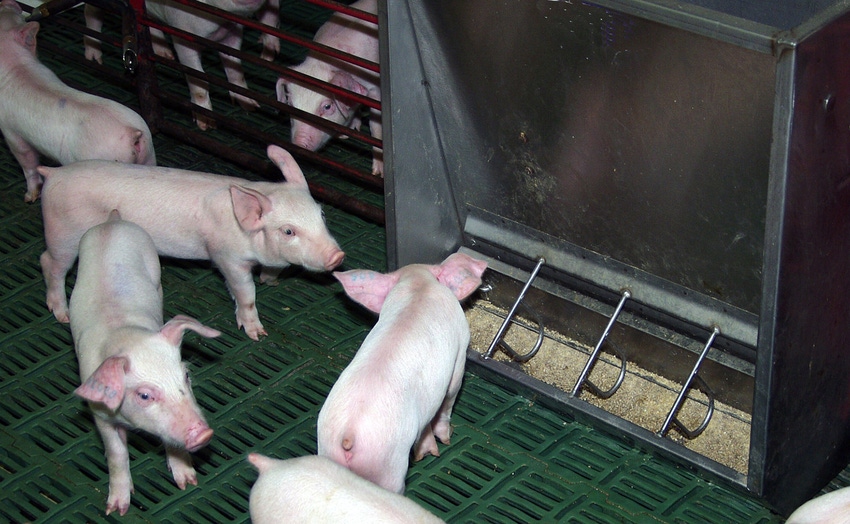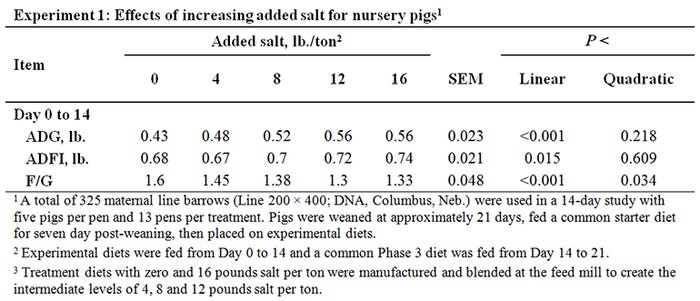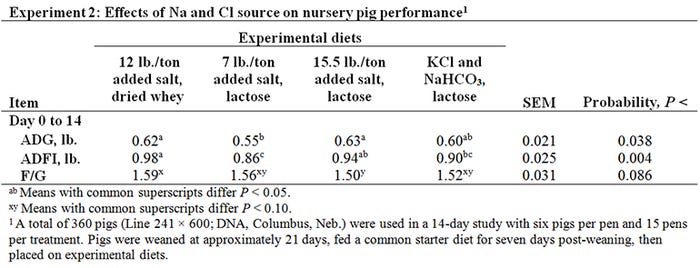Nursery diets should be formulated to the estimated requirement for Na as estimated by the National Research Council for 15- to 25-pound nursery pigs.
March 15, 2017

By D.J. Shawk, M M. Moniz, R.D. Goodband J.M. DeRouchey, M.D. Tokach, S.S. Dritz, J.C. Woodworth, H.E. Williams and A.B. Clark, Kansas State University
Sodium and chloride are key ions that are involved in metabolic processes and electrolyte balance in the body. Salt levels have been positively correlated to growth, feed efficiency and feed intake. Research from Ohio State University observed that in diets containing dried whey with added salt, average daily gain and feed to gain improved up to a total dietary Na and Cl concentration of 0.44% and 0.51%. But when pigs were fed diets containing spray-dried blood plasma and crystalline lactose with added salt, F/G and ADG was maximized by feeding a total dietary Na and Cl concentration of 0.36% and 0.49%, respectively. Based on those findings. the National Research Council (2012) requirements for Na and Cl are 0.35% and 0.45%, respectively, for 15- to 25-pound pigs.
Today, because dried whey will typically contain 2% to 3% salt, many nursery diets will typically contain 5 to7 pounds per ton of added salt. These diets may still be deficient in Na according to NRC (2012) recommendations. Therefore, we conducted two studies to determine the effects of 1) added salt to increase the dietary Na level, and 2) determine if source of Na and Cl impacts nursery pigs weighing 15 to 25 pounds.
In both experiments, pigs were weaned at 21 days of age and after a seven-day period, experimental diets were fed for 14 days. In Experiment 1, 325 barrows initially 14.6 pound body weight were assigned one of five dietary treatments. Treatments included a diet containing 10% dried whey with no added salt, or four, eight, 12 and 16 pounds per ton of added salt. This resulted in calculated dietary Na levels of 0.13%, 0.21%, 0.29%, 0.37% and 0.45%, respectively. From Day 0 to 14, increasing salt increased (linear, P < 0.015) ADG and average daily feed intake. Feed efficiency improved (quadratic, P < 0.034) as added salt increased from zero to 12 pounds with no further benefits observed thereafter. Results of this study confirmed the Na requirement of at least 0.37% as suggested by the NRC 2012.

In the second experiment, 360 pigs were assigned one of four dietary treatments including a 10% dried whey diet with 12 pounds per ton added salt (0.37% Na and 0.75% Cl); or three diets with dried whey replaced by 7.2% lactose and containing either: 7 pounds per ton added salt (0.18% Na and 0.47% Cl); 15.5 pounds per ton added salt (0.35% Na and 0.72% Cl); or 23 pounds per ton sodium bicarbonate and 8 pounds per ton potassium chloride (0.35% Na and 0.45% Cl), respectively. The last treatment diet with sodium bicarbonate and potassium chloride was used to determine if the responses observed in Experiment 1 was maybe due to the Na concentration of the Cl concentration. From Days 0 to 14, pigs fed the 10% dried whey diet with 12 pounds per ton added salt or the diet with lactose and 15.5 pounds per ton added salt had improved (P < 0.05) ADG and ADFI compared to pigs fed the lactose diet with 7 pounds per ton added salt, with pigs fed the lactose diet with 23 pounds per ton sodium bicarbonate and 8 pounds per ton potassium chloride intermediate. However, F/G tended (P < 0.10) to be poorest for pigs fed 10% dried whey compared with pigs fed 7.2% lactose and 15.5 pounds per ton added salt, with others intermediate.

In conclusion, these data support that nursery diets should be formulated to the estimated requirement for Na as estimated by the NRC (2012) for 15- to 25-pound nursery pigs. Formulating to the Na requirement, not a specific added salt level, will more accurately account for ingredient changes like dried whey versus whey permeate, that may alter the final diet Na level.
You May Also Like



